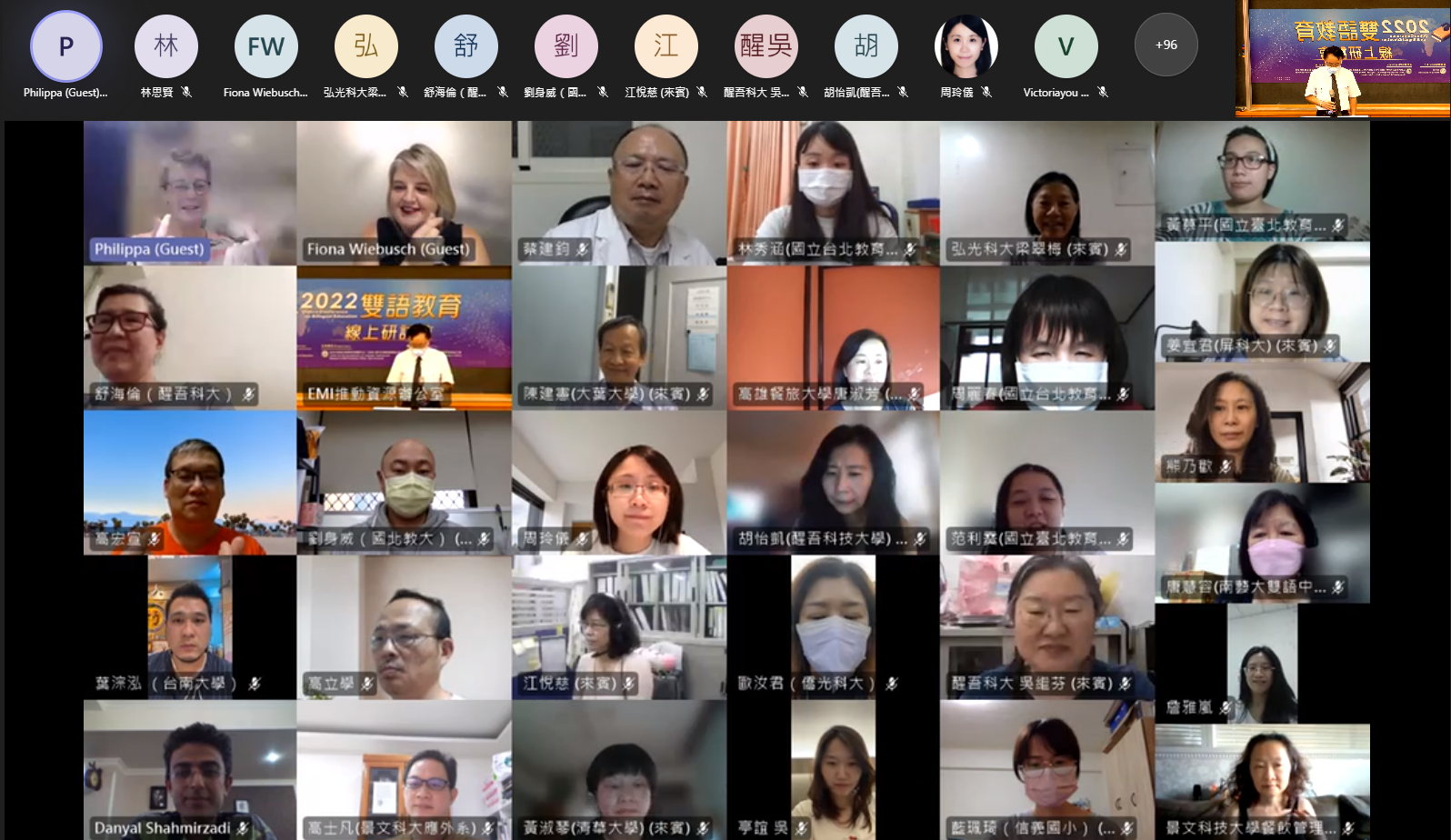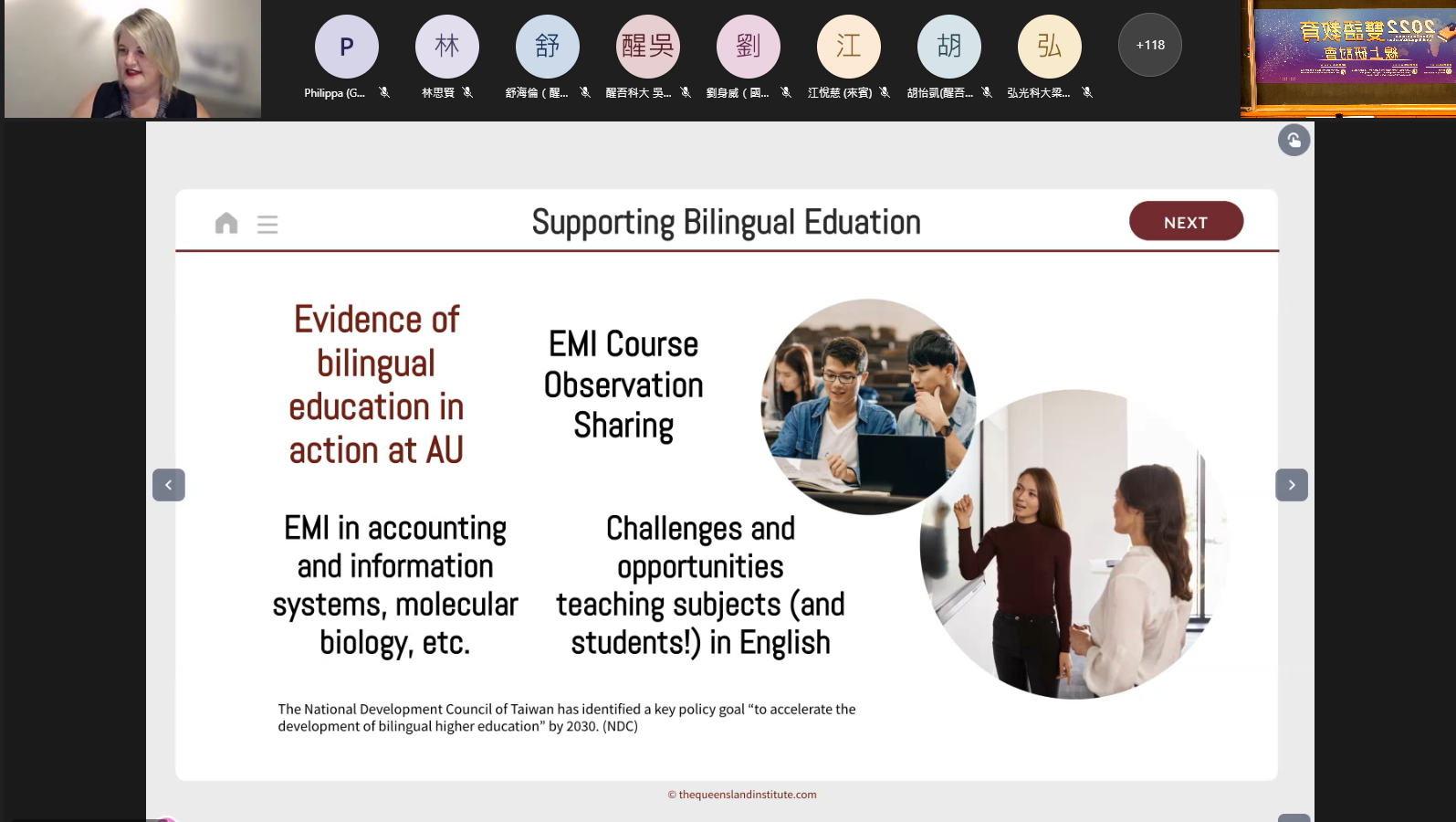

Regional Online Conference on Bilingual Education arranged by the Center for the Development of Language Teaching and Research (CDLTR) at Asia University was hosted on Apr. 22nd, 2022. The conference was a webinar with both online participants and on-site participants joining together.
At the conference, scholars from central Taiwan, Dr. Wen-Ming Yang from National Chung Hsing University, Dr. Shao-Chun Chiu from Asia University, and Dr. Shun-long Chen from Tunghai University were invited to deliver speeches to share their experiences in teaching EMI courses. In addition, foreign lecturers at CDLTR, Mr. Nathan Miller, Mr. Keith Gillibrand, Mr. Paul Kelleher, and Mr. Thomas A. La Grua were invited to share their observation of EMI courses at Asia University. The event was closed with a keynote speech given by Ms. Philippa Colema and Ms. Fiona Wiebsch, senior trainers from Queensland Institute, exploring issues about bilingual education in higher education in Taiwan and sharing experiences in nurturing potential EMI teachers. Over 200 participants were drawn to take part in the event.
Dr. Yinghuei Chen, Dean of International College and Director General of CDLTR, pointed out that the development of EMI courses plays an important role of internationalization in higher education. It’s not only a global trend but is also believed to be the foundation of overall competitiveness of a country. Based upon “The Program on Bilingual Education for Students in Colleges (BEST)” launched by Ministry of Education in 2021, Taiwan’s government expects to nurture international talents by introducing more EMI courses into academic institutions in Taiwan. At this event, representatives from three universities which are chosen for the BEST Program, came to share experiences in developing EMI courses, and to help participants create a picture of how EMI courses have been taught in different contexts. In order to further explore how bilingual education will be developed in Taiwan, CDLTR is planning an international online conference on bilingual education on Jun. 24th, in which James C. F. Huang, Chairman of Taiwan External Trade Development Council and Ben Beaumont, senior trainer at Oxford EMI Center will be invited to deliver keynote speeches.
At the conference, Dr. Shao-Chun Chiu, Assistant Professor from the Department of Accounting and Information Systems of Asia University, shared a number of techniques to encourage students to contribute to class discussion, including taking advantage of Google Translator to confirm students’ comprehension of course materials and using visual aids such as videos from YouTube to draw their attention. Dr. Wen-Ming Yang from National Chung Hsing University, who tackled EMI from another angle, talked about some tips of improving speaking skills, and pointed out that though some students and even teachers might be anxious about EMI courses at the beginning; however, with tools such as TED videos and Grammarly that are easy to use, they would find their English proficiency is improving grossly. Dr. Shun-long Chen, Associate Professor from Tunghai University emphasized that general English courses for freshman needed reform on course design, course content and the instruction accordingly, engaging students more in EMI class. Mr. Nathan Miller, a foreign lecturer at CDLTR, observed that some Taiwanese teachers were concerned about students’ comprehension and tended to repeat what they said again and again either in Chinese or in English. However, using simple words to deliver the content could more effectively assist students in class.
Senior trainers from Queensland Institute, Ms. Philippa Coleman and Ms. Fiona Wiebsch, who have collaborated with Asia University to host a couple of training programs for teachers since 2016, indicated that CLIL strategies such as “collaborative listening and writing,” “peer review” and “demonstration and learning” could be applied in class and would successfully help teachers to facilitate class interaction and discussion between students.
Participants from various academic institutions gave positive feedback to the conference; not only did they raise a lot of questions after each session, but they were keen to interact with other participants or speakers at the conference.
At the conference, scholars from central Taiwan, Dr. Wen-Ming Yang from National Chung Hsing University, Dr. Shao-Chun Chiu from Asia University, and Dr. Shun-long Chen from Tunghai University were invited to deliver speeches to share their experiences in teaching EMI courses. In addition, foreign lecturers at CDLTR, Mr. Nathan Miller, Mr. Keith Gillibrand, Mr. Paul Kelleher, and Mr. Thomas A. La Grua were invited to share their observation of EMI courses at Asia University. The event was closed with a keynote speech given by Ms. Philippa Colema and Ms. Fiona Wiebsch, senior trainers from Queensland Institute, exploring issues about bilingual education in higher education in Taiwan and sharing experiences in nurturing potential EMI teachers. Over 200 participants were drawn to take part in the event.
Dr. Yinghuei Chen, Dean of International College and Director General of CDLTR, pointed out that the development of EMI courses plays an important role of internationalization in higher education. It’s not only a global trend but is also believed to be the foundation of overall competitiveness of a country. Based upon “The Program on Bilingual Education for Students in Colleges (BEST)” launched by Ministry of Education in 2021, Taiwan’s government expects to nurture international talents by introducing more EMI courses into academic institutions in Taiwan. At this event, representatives from three universities which are chosen for the BEST Program, came to share experiences in developing EMI courses, and to help participants create a picture of how EMI courses have been taught in different contexts. In order to further explore how bilingual education will be developed in Taiwan, CDLTR is planning an international online conference on bilingual education on Jun. 24th, in which James C. F. Huang, Chairman of Taiwan External Trade Development Council and Ben Beaumont, senior trainer at Oxford EMI Center will be invited to deliver keynote speeches.
At the conference, Dr. Shao-Chun Chiu, Assistant Professor from the Department of Accounting and Information Systems of Asia University, shared a number of techniques to encourage students to contribute to class discussion, including taking advantage of Google Translator to confirm students’ comprehension of course materials and using visual aids such as videos from YouTube to draw their attention. Dr. Wen-Ming Yang from National Chung Hsing University, who tackled EMI from another angle, talked about some tips of improving speaking skills, and pointed out that though some students and even teachers might be anxious about EMI courses at the beginning; however, with tools such as TED videos and Grammarly that are easy to use, they would find their English proficiency is improving grossly. Dr. Shun-long Chen, Associate Professor from Tunghai University emphasized that general English courses for freshman needed reform on course design, course content and the instruction accordingly, engaging students more in EMI class. Mr. Nathan Miller, a foreign lecturer at CDLTR, observed that some Taiwanese teachers were concerned about students’ comprehension and tended to repeat what they said again and again either in Chinese or in English. However, using simple words to deliver the content could more effectively assist students in class.
Senior trainers from Queensland Institute, Ms. Philippa Coleman and Ms. Fiona Wiebsch, who have collaborated with Asia University to host a couple of training programs for teachers since 2016, indicated that CLIL strategies such as “collaborative listening and writing,” “peer review” and “demonstration and learning” could be applied in class and would successfully help teachers to facilitate class interaction and discussion between students.
Participants from various academic institutions gave positive feedback to the conference; not only did they raise a lot of questions after each session, but they were keen to interact with other participants or speakers at the conference.


 EMI推動資源辦公室
EMI推動資源辦公室